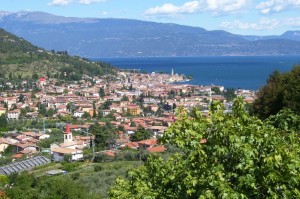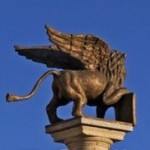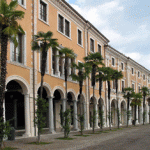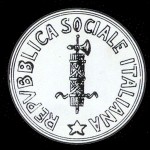Salo’ is protected within its bay, formed by the promontory of San Felice del Benaco,
 Salo’ is a town with an important past, was an ancient reference to the time of the Venetian Republic from the fourteenth to the eighteenth century, and from 1943 to 1945 was one of the Repubblica di Salo’ or Italian Social Republic (RSI) formed by Mussolini with the presence of various government buildings. Of particular interest is the Palazzo della Magnifica Patria built in 1524 on designs of Sansovino and rebuilt after the earthquake of 1901 and the Dome of the fifteenth century, with many many works of art. Salo’, by its geographical position and road, is a crossroads between the Garda, the Riviera dei Lemoni, Valle Sabbia and Valley of Chiese, is a popular town especially in recent years has changed its appearance with a significant aesthetic improvement and services, with the arrangement of the whole lake, new parking lots and areas close to the city center is raising as valid tourist center as an alternative to other more well-known and popular of Garda lake.
Salo’ is a town with an important past, was an ancient reference to the time of the Venetian Republic from the fourteenth to the eighteenth century, and from 1943 to 1945 was one of the Repubblica di Salo’ or Italian Social Republic (RSI) formed by Mussolini with the presence of various government buildings. Of particular interest is the Palazzo della Magnifica Patria built in 1524 on designs of Sansovino and rebuilt after the earthquake of 1901 and the Dome of the fifteenth century, with many many works of art. Salo’, by its geographical position and road, is a crossroads between the Garda, the Riviera dei Lemoni, Valle Sabbia and Valley of Chiese, is a popular town especially in recent years has changed its appearance with a significant aesthetic improvement and services, with the arrangement of the whole lake, new parking lots and areas close to the city center is raising as valid tourist center as an alternative to other more well-known and popular of Garda lake.
TERRITORY OF SALO’
Province: Brescia
Surrounding municipalities: Gardone Riviera, Gavardo, Puegnago, Roè Volciano, San Felice del Benaco, Vobarno.
The town of Salo’ is located in a basin formed between the morainic hills that form the Valtenesi, the mountains that form the Alto Garda Bresciano Park, the Riviera dei Limoni and the passage that leads from Lake Garda in the Valle del Chiese and the Valle Sabbia, a crossroads between these regions. Compared to the old town in the south are the hamlets of Cunettone and Villa, west is Campoverde, north are Serniga, Renzano and Barbarano. Geologically, the town is located on the seismic-tectonic benacense area, that is prone to earthquakes, as demonstrated by the earthquakes of 1901 and 2004, of 8° degrees on the Mercalli scale.
HISTORY OF SALO’
The story of Salo’ is rich, on the etymology of its name we can do different interpretations, including the most probable, however, that the precious salt binds to the Adriatic, was deposited here by the Romans and then marketed .
 After the probable Neolithic settlements, it is clear that the coming of the Romans still left numerous traces, such as the necropolis in street Sant’ Jago. In 1334, Salo’ joins the towns of the Riviera and the Val Sabbia, to form a federation with capital Maderno led by a superintendent sent by the Republic of Venice, in order to maintain autonomy from Brescia and Verona. But in 1350 the Riviera falls into the hands of Visconti, who allocate Salo’ to become the new capital in 1362, a bond lasted until 1428 when, after the death of Duke Galeazzo Visconti, the towns of the Riviera decided to go back under the Serenissima influence. Venice, however, conquered Brescia and decides to put these towns in Brescia jurisdiction.
After the probable Neolithic settlements, it is clear that the coming of the Romans still left numerous traces, such as the necropolis in street Sant’ Jago. In 1334, Salo’ joins the towns of the Riviera and the Val Sabbia, to form a federation with capital Maderno led by a superintendent sent by the Republic of Venice, in order to maintain autonomy from Brescia and Verona. But in 1350 the Riviera falls into the hands of Visconti, who allocate Salo’ to become the new capital in 1362, a bond lasted until 1428 when, after the death of Duke Galeazzo Visconti, the towns of the Riviera decided to go back under the Serenissima influence. Venice, however, conquered Brescia and decides to put these towns in Brescia jurisdiction.
Only in 1443 the Riviera is partially separated by Brescia and Salo’ obtain again the superintendent sent by the Venetian Senate, in this way the coastal villages became part of the “Magnifica Patria“, the Venetian state almost of its own with autonomy and privileges. To decree the end will be the arrival of Napoleon in 1796, which took off to Salo’ the title of capital and the independence from Brescia, with the Treaty of Campoformio the Venetian state passed under the Habsburg Empire.
On the soil of Salo’ in 1814 the Napoleon Kingdom of Italy is defeated in the battle against the Habsburg Kingdom, then received favorably by the town. During the Austrian occupation Salo’ will be named the capital of the District XIV Imperial Regia Delegation of Brescia.
With the start of the riots of 1848 Salo’ takes a position in the National Guard against the Habsburg hegemony and well see the arrival of Garibaldi in 1859, with the Armistice of Villafranca Salo’ and Lombardy became part of the Kingdom of Sardinia and from here to that of the Italya united and became the new capital of the Riviera and the Val Sabbia.
In 1901, a powerful earthquake put Salo’ on knees, forcing it to rebuild its squares (born Piazza Sant’ Antonio and Piazza Zanardelli) and assume a new face.
During the Second World War, Salo’ assumed the role of the capital of Italy and in 1943 became the cradle of the Italian Social Republic, the last attempt of Benito Mussolini to reorganize the Fascist Italy.
In the sixties Salo’ finds its vocation in tourism, with its charm and beauty of the places that history has left us.
